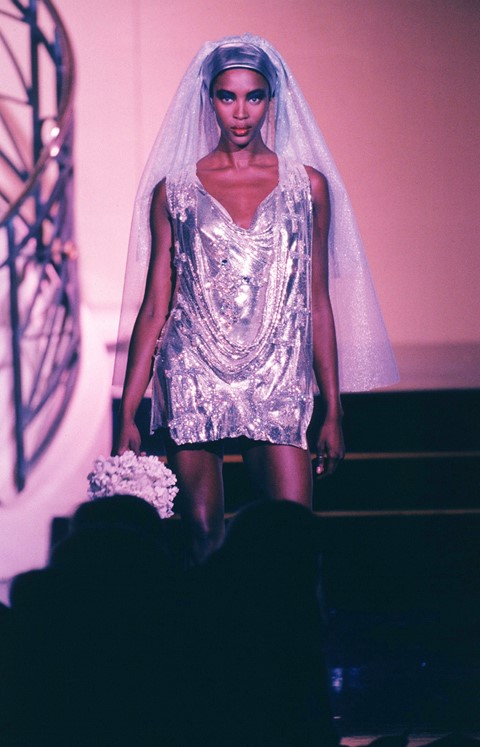Alexander Fury considers Gianni Versace’s final collection, a powerful evocation of Byzantine symbolism which dismissed any conventions of luxury or beauty
In the month Heavenly Bodies: Fashion and the Catholic Imagination opens at the Metropolitan Museum of Art in New York, anothermag.com is running a series of The Shows That Matter on collections that tackled religion, head on. Here, Alexander Fury considers Atelier Versace F/W97, Gianni Versace’s final collection and creative epitaph.
Gianni Versace’s Autumn/Winter 1997 Atelier Versace show is a show that matters for two reasons, the most obvious being the reason the world knows: it was the designer’s last. The collection was presented in Paris on 6 July 1997; nine days later, on the morning of 15 July, Versace was murdered by American spree killer Andrew Cunanan on the steps of his Miami mansion, Casa Casuarina. An explosion of international press followed, which continues until today, almost 21 years later – the FX anthology television series, The Assassination of Gianni Versace: American Crime Story, began screening this year, offering a broadly fictionalised account of the Versace murder. It of course included a small snippet of that final fashion show.
The second reason, however, is more compelling. It was a great collection – attuned to the times, addressing both the aesthetic fixations of current fashions (shoulder pads had made a big comeback the previous ready-to-wear season; Versace built this couture collection around them) and the direction of culture as a whole, as expressed through fashion.
For the previous few seasons Versace had been grappling with the shift in fashion away from the bombshell curves and souped-up sex appeal that he had pioneered, and towards two opposite but equally different poles: the historical histrionics of John Galliano, and the sharply cut, skinny-tailored and elegantly wasted look of heroin chic. The latter could encompass some of the work of Lee Alexander McQueen, with his signature pointed and padded shoulders and air of intentional distress and dishevelment. McQueen’s Autumn/Winter 1995 collection, Highland Rape, was controversial not only for its subject – taken to mean the rape of women, as opposed to its intentional reference to the genocide of the highland clearances of the 18th and 19th centuries – but also in its eschewing of conventional notions of beauty and luxury. Here, Versace challenged those conventions, within his own aesthetic.
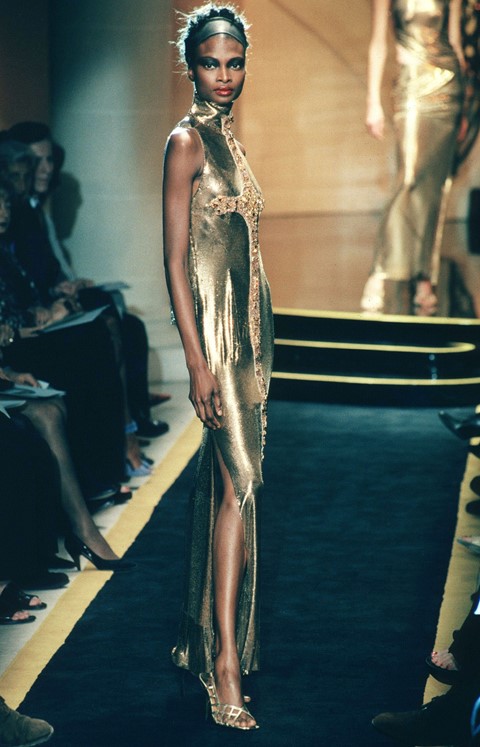
The Show
Versace habitually staged his Atelier shows during Paris haute couture week – he had done so since 1989, eschewing the Roman alta moda presentations, which until then still counted big league designers including Gianfranco Ferré and Valentino among their ranks (both subsequently moved to Paris also). In contrast to the vast, spotlit ready-to-wear shows in Milan, Versace’s Paris shows were usually more intimate affairs, as befits the demands of haute couture and its clients. His first were quiet presentations – unlikely, but true – and, at his debut, Versace presented just 14 styles in a suite at the Hôtel Meurice, but sold an outstanding 52 pieces. He began showing in January 1990, and from the outset his favoured venue was swimming pool of the Hôtel Ritz in Paris, its depths boarded over into a cosseted, windowless cell of glamour that seated just 350 (Versace had to stage two shows to fit all the press, clients and celebrities). It is now a Chanel-branded spa.
The pool at the Ritz was itself an interloper, it was only built in 1987, following a $250 million, seven-year refurbishment of the then-89 year old edifice headed by the architect Bernard Gauchere, the first in its history. It was fitting for Versace, who was seen as something of an arriviste into the ranks of haute couture. It was also an ideal location given that the pool’s construction was inspired by ancient Greek and Roman baths, keyed to Versace’s own interest in mythology and use of its aesthetics throughout his design – not least his medusa logo and Greek key emblems. For this occasion, Gianni Versace carpeted the space in black bordered with brilliant, acidic yellow, the two key colours of the clothes, and had his models descend the curling double-staircases at the back of the runway sometimes two at a time, in mirrored formation.
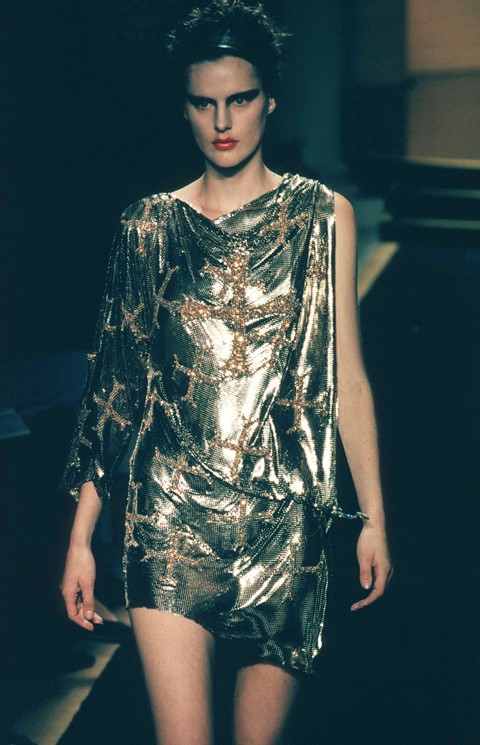
The People
As with every Versace show, the models were boldface, immediately recognisable names, which at that point included old school supermodels, the established likes of Shalom Harlow, Amber Valletta and Stella Tennant, and a newer breed including Erin O’Connor, Esther Cañadas, and the Mancunian up-and-comer Karen Elson. An auburn-haired 18 year old from Oldham, Elson had debuted in the Chanel ready-to-wear show only that March, with a choppy bob and eyebrows freshly shaved after a Steven Meisel shoot for Vogue Italia. She was dubbed ‘le Freak’, but was the most fashionable model of the moment. She had already been shot, by Richard Avedon, for the Autumn/Winter 1997 Versace ready-to-wear advertising campaign.
Originally, the finale wedding dress from this Versace show was to be worn by Elson – footage exists of Gianni Versace rehearsing the model walking the carpeted catwalk, sporting a white veil embroidered with a cross pulled down over her face. That footage was featured in Undressed: Fashion in the Twentieth Century, a documentary series by Gideon Koppell and the former British Elle editor-in-chief, the late Sally Brampton, in an episode fittingly devoted to ‘Sex’, which Versace was a master of. The final show, however, featured Naomi Campbell wearing the dress, with the veil pulled back from her face.
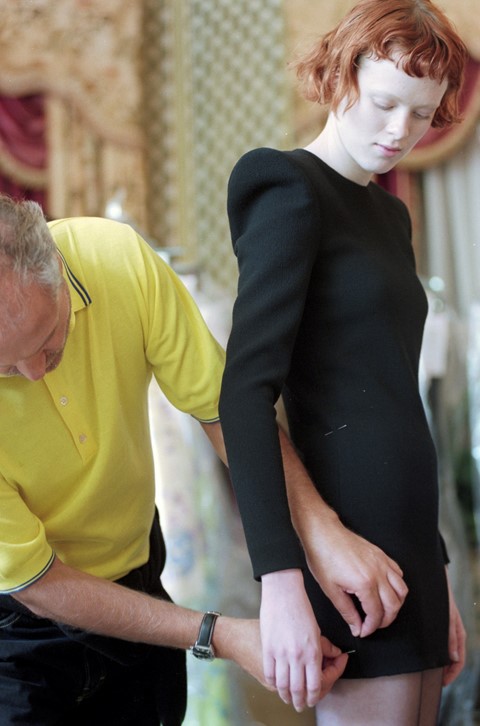
“Gianni never liked [Elson],” the author Deborah Ball wrote in a 2010 book, House of Versace: The Untold Story of Genius, Murder, and Survival. “‘Why are you so pale?’ he used to demand of Elson, in Italian. The British girl looked blankly at him. ‘Why don’t you go get some sun?’” Nevertheless, she modelled two outfits in this show.
Elson’s inclusion was also a mark of the influence of Donatella Versace, dubbed her brother’s muse (“I ‘ate the word,” she later told me) but in actual fact a vital creative collaborator at every level. This extended, particularly, to the choices of models – Donatella Versace had pushed Gianni to include supermodels in his shows, picking up on the phenomenal success they were about to enjoy, and becoming the catalyst for it. Here, she championed that new generation – Erin O’Connor would become the face of Donatella’s first solo advertising campaign, for the following spring season.
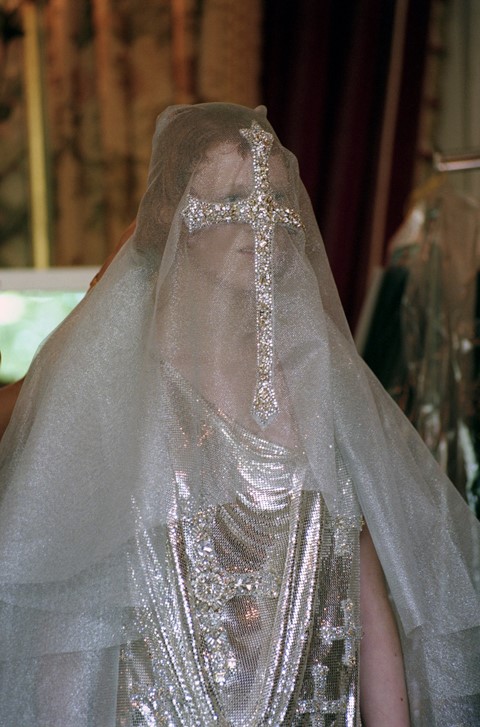
The Impact
The collection itself is in hindsight eerily prescient. It was dominated by black: 53 of the 83 looks were either predominantly or solely black. There was also an underlying religious theme – the collection was encrusted with oversized jewelled crosses inspired, Versace said, by the Glory of Byzantium show at New York’s Metropolitan Museum of Art, where these dresses are currently on show as part of this year’s Heavenly Bodies: Fashion and the Catholic Imagination. Many of the clothes made a powerful play on monochrome recalling nun’s habits (albeit the sexiest in history), while the models’ hair was pulled back from their foreheads like Renaissance portraits.
Yet this collection also indicated a new direction for Versace, one not so much influenced by Galliano and McQueen, who debuted the previous season at Dior and Givenchy, respectively, but certainly inspired by a competitive spirit. “Mr Versace pushed himself as hard as the younger bucks did,” said fashion critic Amy Spindler in The New York Times. “His couture is indeed a laboratory, and for every dress that took the idea a step too far, there was one where the idea worked.” Versace’s experimentation with shoulder pads, then enjoying an ironic resurgence via neo-80s styles, particularly at the hand of McQueen (his Autumn/Winter 1997 ready-to-wear collection for Givenchy was inspired in part by the drag festival Wigstock, and again by Joan Collins in Dynasty), was perfectly in tune with the times. Yet Versace had designed with shoulder pads the first time around, so this time he twisted and pulled and toyed with the idea, exposing them outside dresses and encrusting them with crystals or his signature Oroton aluminium mesh. It was a style that would influence fashion for the next half decade and one that rears its head even today.
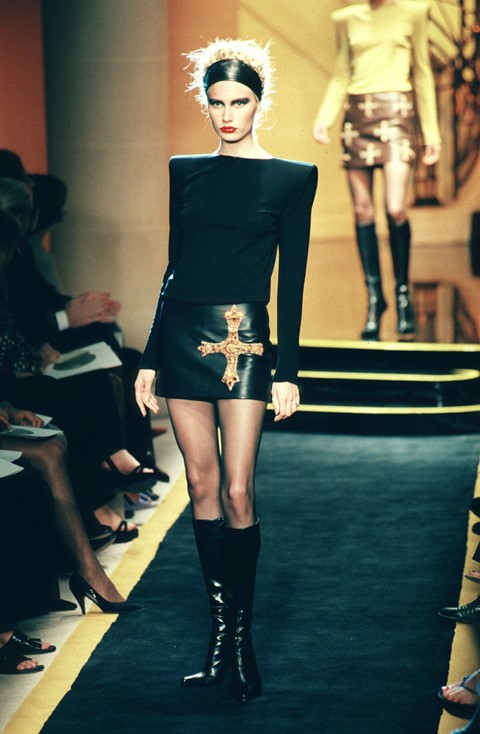
“My favourite collection of Gianni was his last collection, the one with the crosses, the Byzantine one,” Donatella Versace told me last November for AnOther Magazine’s Spring issue. However, she didn’t reference it in her own Tribute collection because “It’s too close to what people, young designers are doing today.”
It was also the collection that served as Gianni Versace’s creative epitaph, his final fashion statement. It is a collection that beautifully married not only the sacred and the profane – a dress cut with the piety of a nun’s habit but clinging to the body and slit to the hip; a wedding gown abbreviated at the upper thigh and encrusted with ornament like an Orthodox iconostasis – but also Versace’s love of decoration and feminine sensuality with the changing fashion climate. It produced a new synthesis of his style for the times. Today, this collection stands as a tantalising ‘what if’ as to the path Gianni Versace would have trodden if his life had continued. As it is, these clothes belong in a museum. Which, fittingly, is exactly where they have ended up.
Heavenly Bodies: Fashion and the Catholic Imagination at the The Metropolitan Museum of Art, New York runs from May 10 – October 8, 2018.
